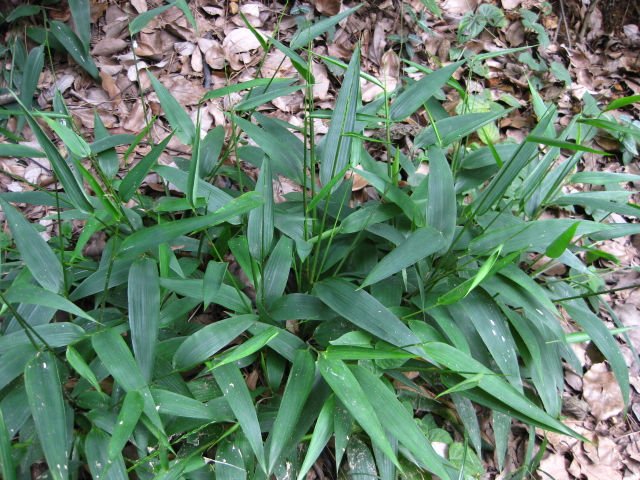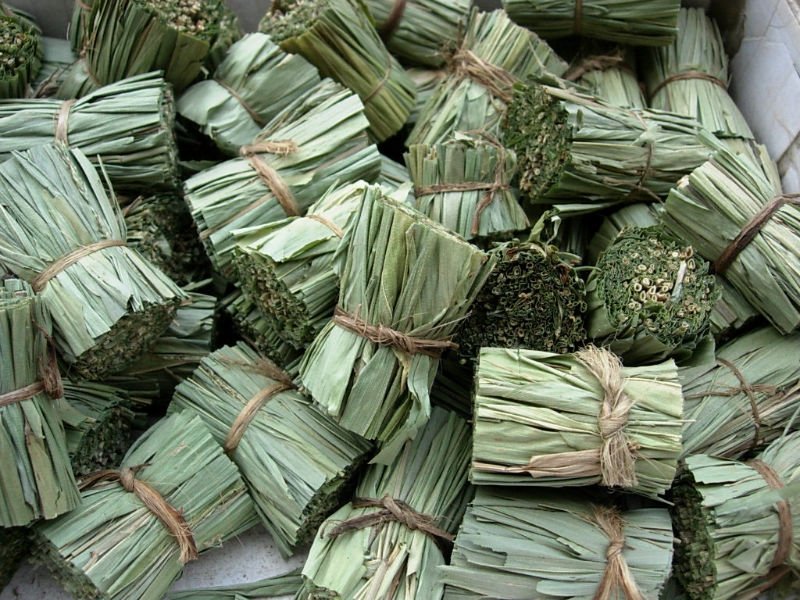- Late stage febrile disease: residual fever, sensation of heat and irritability
in the chest, desire for cold beverages, T- red with thin coating, use with
Calcium sulphate- Shi gao.
[4]
- Sensation of irritability in the chest with thirst due to febrile disease,
with
Ophipogon japonicus- Mai men dong,
Phragmites communis- Lu gen,
Trichosanthes
kirilowii- Tian hua fen.
[4]
- Sensation of heat and irritability in the chest, sore of the mouth and tongue
and dark, scanty urine due to Heat in the Heart channel. Use with
Clematis
armandii- Mu tong and
Rehmannia glutinosa-
Sheng di huang.
[4]
Perennial herb. Rhizomes almost woody, fibrous roots expanded thick and fleshy
like spindles at tips or midsections. Stem: slender and long, yellow, with longitudinal
furrows. Leaves: alternate, lanceolate or broadly lanceolate, apexes acuminate,
bases sheathed and clasping stem, ribs parallel, both surfaces pubescent, white
noded at leaf achrea. Flowers: in summer, small green terminal flowers appear
to form panicle inflorescences. Caryopsis: dark brown.
[1] Barefoot Doctor's Manual- 1977 Prepared
by the Revolutionary Health Committee of Hunan Province. Original Chinese manual-
Victor W. Sidel. Originally published by Dr Joseph Quin and the Fogarty International
centre, Bethdesda (1974). Madrona Publishers Seattle Washington ISBN 0-914842-52-8
[2] A Complete English Dictionary of Medicinal Terms in Chinese Acupuncture
and Herbalism 1981- Henry Lu Chinese Foundations of Natural Health- The Academy
of Oriental Heritage, Vancouver, Canada.
[3] Translation notes from Gary Seiford and Hocu Huhn- NSW College of Natural
Therapies. Sydney Australia (1982).
[4] Chinese Herbal Medicine Materia Medica- Dan Bensky and Andrew Gamble- Eastland
Press 1986 Seattle Washington ISBN 0-939616-15-7
[5]
americandragon.com
by Joel Penner
Images
1.
alibaba.com
2.
[1]
3.
gwzft.en.alibaba.com Both Dan zhu
ye and
Gardinia jasminoides- Zhi zi
cool Heat, eliminate irritability and facilitate urination. Zhi zi is very bitter
and cold, enters both the Qi and Blood levels, drains constrained Heat from
the Triple heater, cools the Blood and resolves toxicity while clearing the
Liver and Gallbladder. It excels at eliminating irritable constraint. Dan zhu
ye has milder properties, enters only the Qi level, is not only bitter and cold
but also acrid and can vent and disseminate Heat. It primarily treats Heart
and Lungs and to some extent Stomach. It is also good for cough due to Wind-Heat
and mouth ulcers due to Heat in the Heart.
[1]
References
[1]
americandragon.com
by Joel Penner
Arundoin, cyulindrin,
taraxerol, friedelin.[1]
References
[1] Chinese Herbal Medicine Materia Medica- Dan Bensky and Andrew Gamble- Eastland
Press 1986 Seattle Washington ISBN 0-939616-15-7
 Lophatherum
gracile. 淡
竹 叶
Dàn zhú yè Bamboo leaf,
Bamboo grass,
Common Lophatherum Family: Gramineae
Lophatherum
gracile. 淡
竹 叶
Dàn zhú yè Bamboo leaf,
Bamboo grass,
Common Lophatherum Family: Gramineae

 Research
Research